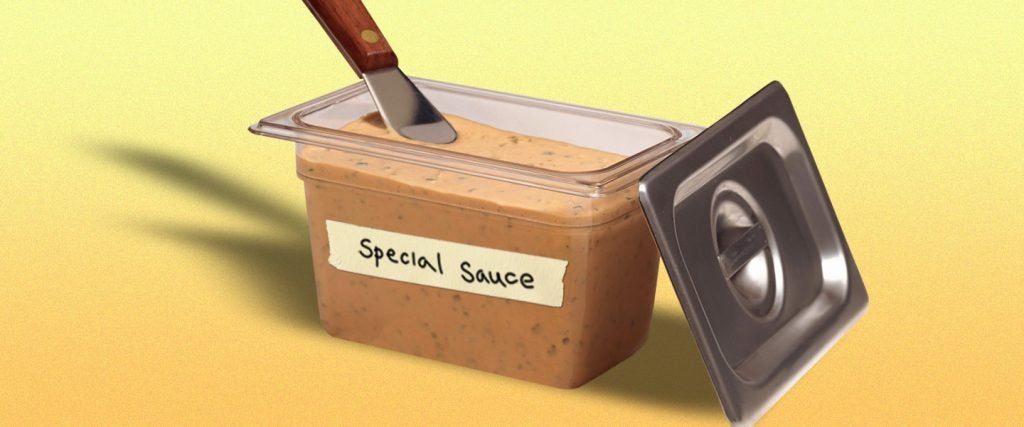The term “special sauce” is so generic that its origins are literally untraceable. That’s the official word I got from no less an authority than Barry Popik, the man who the Wall Street Journal has described as “the restless genius of American etymology.” Popik has dug up the origin of phrases like “The Big Apple” and is a consultant for the Oxford English Dictionary, but when I asked him about the history of the phrase “special sauce,” he told me it was “too common to check.”
Which means that the term “special sauce” is truly anything but special. In fact, all kinds of people have thought their sauces were special enough to receive the “special sauce” designation over the last 200 years. (Merriam Webster notes that the phrase dates back to at least 1848.) In the 1899 edition of The White House Cook Book, a recipe for “Haunch of Venison,” calls for a “special sauce” comprised of red wine and currant jelly. In the 1880 cookbook, An Easy and Economical Book of Jewish Cookery, there is a “special sauce” for fish made from flour, oil, vinegar, several spices and the “liquor the fish was boiled in” (whatever that means). And in an 1858 edition of the New York Times, I found a column referencing the newly published Modern Cook, which touted “a catalogue of no less than 92 ‘special sauces.’”
Per Popik, special sauce made its way atop burgers in the 1940s. In particular, he cited a 1949 ad for the Pier 40 Tavern in Honolulu, which served “De Luxe hamburgers” with “Ann’s special sauce.” There was also a 1952 ad for the Green Room at the Hotel Heidelberg in Jackson, Mississippi. They were offering an “open-faced jumbo hamburger [with] special sauce” for 70 cents.

The most famous instance of “special sauce,” of course, arrived in 1967 with the birth of the Big Mac, which was created by McDonald’s franchise owner Michael Delligatti in Uniontown, Pennsylvania. He added the sandwich to his menu to compete with other local burger joints. When it became successful, McDonald’s Corporate adopted it, and in 1968, they ran their first ad for it. According to Mashed, “In the original 1968 commercial, McDonald’s never mentioned a ‘special sauce.’ They called their new creation ‘secret’ sauce.” That expression — “secret sauce” — dates back to at least 1906 and is also a pretty generic turn of phrase.
“Secret sauce” didn’t become “special sauce” until McDonald’s launched a new ad campaign in 1974, in which a new jingle listed all of the Big Mac ingredients in a rapid-fire way: “Two all-beef patties, special sauce, lettuce, cheese, pickles, onions on a sesame seed bun.” McDonald’s never explained the change from “secret” to “special,” but the sauce has remained “special” since. Because of that, most now equate “special sauce” with McDonald’s. As Popik explains, “McDonald’s popularized ‘special sauce’ in December 1974.”
Many people believe that McDonald’s special sauce is nothing more than Thousand Island dressing, and although Thousand Island dressing has a variety of recipes, they usually consist of ketchup, mayo and relish. McDonald’s special sauce, however, doesn’t include ketchup, which means it really isn’t Thousand Island dressing. Instead, it contains mayo, relish, mustard, vinegar, garlic powder, onion powder and paprika — we know that because McDonald’s has been open about the recipe for well over a decade.
Despite the name, when you take a look at the ingredients for McDonald’s special sauce, there isn’t really anything special about it. Yet the phrase “special sauce” — which predated McDonald’s by more than a century — is now synonymous with the fast-food chain, largely on the strength (and repetition) of that initial Big Mac jingle.
Back in 2008, the New York Times spoke with creator of the jingle, Keith Reinhard, a member of the Advertising Hall of Fame, and he told them that the concept was born out of “exasperation.” His agency wanted to promote the Big Mac with a parody of a song from A Chorus Line, but McDonald’s insisted that they had to list the Big Mac ingredients in the ad. On an easel, the advertising team had the ingredients written out and Reinhard said, “Remember how we told our kids to learn the ABCs with sort of a dumb tuneless chant?” From there, Reinhard’s partner, Dan Nichols, came up with the legendary Big Mac chant: “Two all-beef patties, special sauce, lettuce, cheese, pickles, onions, on a sesame-seed bun.”
The music in the commercials was performed by musician Mark Vieha, and the campaign would turn out to be a huge success, spawning commercial after commercial after commercial, several of which even featured people trying — and failing — to recite the chant properly.
“A lot of successful jingles are like children’s songs,” explains Timothy D. Taylor, author of The Sounds of Capitalism: Advertising, Music and the Conquest of Culture. “They’re very simple, they’re very catchy and they’re very easy to remember. The Big Mac jingle had a lot of that — it had a nursery rhyme-y kind of feel to it. But because it was hard to say, it had a tongue-twister appeal as well. While it was hard to say, that was the conceit of the jingle, which added another layer to it and made it extra memorable.”
So memorable, that it would forever link the generic-as-hell expression “special sauce” to the McDonald’s Big Mac — even if there was absolutely nothing special about the sauce in the first place.

